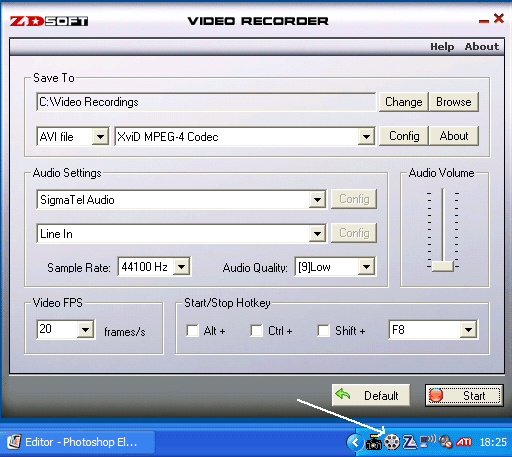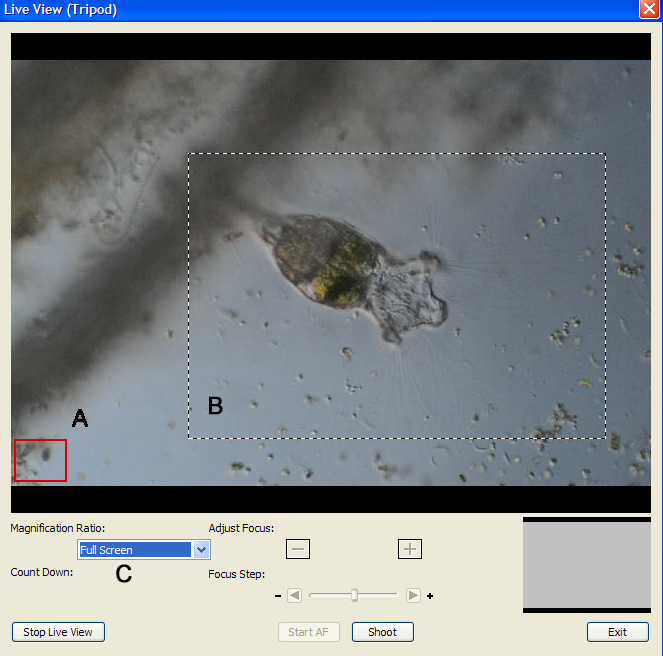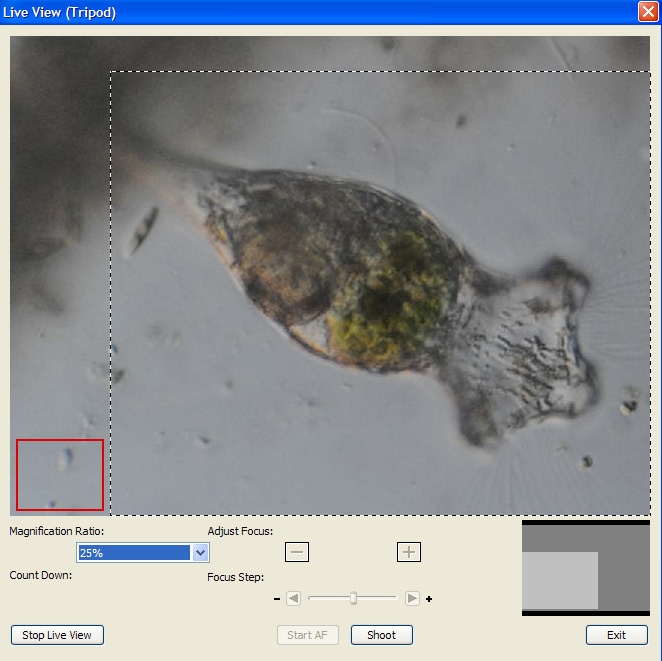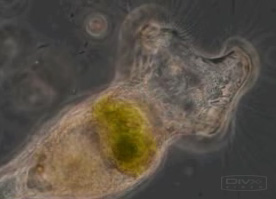| Video microscopy trials with
the USB Live View output of a DLSR camera.
by David Walker
|
'Live
View' from the main sensor is an increasingly popular feature on
the digital SLRs offered by most makers. The live image can be
viewed in a number of ways: on the camera's LCD, on a TV via the video
output(s) and also on a computer screen via a USB cable with the
maker's remote control software (if available).
The
author has been using a Nikon D300 with its live view feature for
critical focussing in photomicroscopy (see January 208 Micscape article) and
wondered if the PC screen video stream could be captured, so that the
DSLR effectively became both a still image camera and a video camera.
I was
unfamiliar with what software could capture the video stream on
screen but an online search showed that live view video capture
from DSLRs was already being explored e.g. by photographers interested
in video macroscopy. One useful forum discussion 'How to capture video from 40D?' in a DPreview forum
discussed software that users had been trying. The software that most appealed to
me, both in effectiveness and price, was ZDSoft's
'Video Recorder'. A 30 day free trial is available and good value
to buy at $29.
The
videos below were all captured using this software and the Nikon D300,
but any DSLR that has control software that presents live video on the PC screen
should be fine.
The software was very robust and gave no problems at all with Nikon's
software.
Video
recording alternative routes: The video output from a DSLR with live
view can of course also be captured via the composite video output
(and/or high definition if offered) to a suitable video recorder. This
should give the best quality but the potential benefit of capturing the
USB video stream is for computer and web page use without the
need to play back the video recorder and use a video capture board.
|
ZDSoft's Video Recorder screen shown
right is very intuitive. The software detects the video codecs on the
PC and offers them in a drop down box. The parameters available for
each codec can be altered via the 'Config' button,
e.g. compression rates etc.
When the Start button is pressed the
arrowed film reel icon in the status bar rotates to indicate
recording is in progress. The button to stop and start video can be
configured to suit.
By default video files are saved
with sequential file names so no danger of overwriting them.
If the PC has a built in microphone or
one is connected to the PC's audio card, an audio commentary could be
added.
|

|

Above:
The 'Live View' box of Nikon Capture Control Pro 2 using a Nikon
D300 on a microscope. Before starting the video recording software, the
camera's red focus box 'A' can be put in a corner so as not to be in
video field. When the video recorder Start button is pressed, a
floating crop area is enabled 'B' that allows the user to select the
screen area to be captured. Once selected the software starts recording.
Notice that the 'Magnification Ratio' 'C' is set to 'Full Screen' to
capture the camera's full sensor area.
One of the benefits of the user selectable video capture area is
that non-standard aspect ratios can be selected to suit the subject.
The maximum capture area is defined by the camera's control software,
in this case 640x480, but that is more than sufficient for most
computer use.

Above:
A potentially useful feature is to use the 'Magnification Ratio' box to
fill the screen without changing mag. This admittedly is a type of
digital zoom but as the sensor has a huge pixel count if used with
caution, image quality didn't seem to be affected. I didn't find much
above 25% worth doing, an increase in microscope objective mag would be
better.
Videos
- to play a video of interest below, click on an image and it
will
play in an external window using the default avi player on the local PC. Note that the Xvid compression codec is used.
Readers may need to download the codecs from www.xvid.org
if not on local PC.
Clips
edited with free Virtual Dub. Apart
from cutting out frames and compression, the videos are as seen on the PC screen from the
Nikon D300's Live View window. The video quality on Live View screen
was higher than shown here because of compression and frame rate reduction to
save file size. (fps in captions = frames per second).
Pond
life - Vorticella

Vorticella,
Zeiss 16x objective, brightfield, contrast enhanced lighting. Not a
lot of movement in this video but shows fine tone retention and liked
the arrangement of the individual specimens.
Clip 10 secs, 564 kbytes, 10 fps from original 20 fps.
One of the benefits of the ZDSoft video capture is that the capture
box can be fitted to suit the subject being viewed, rather than having
to adopt a fixed format.

Vorticella - close-ups
of above colony with the same Zeiss 16x objective but with 25% Live View zoom-in
on screen of same field as above . Brightfield, contrast enhanced lighting.
The three specimens obligingly remained extended and in same plane of
focus to show both cilia crown and side view.
As remarked
in the introduction, the zoom-in function of the camera's Live View
can be used with care to magnify the subject without changing
objective, thus retaining the depth of field of the lower power.
Clip 10 secs,
1.7 Mbytes, 10 fps from 20 fps master. Monochrome
set in camera. The compression parameters need to be chosen with care.
Those for Xvid are dauntingly extensive and have yet to gets to
grips with what they all do to optimise video clips for web use. Some
'stepping' of fine gradations in backgrounds can occur during compression
during master recording to hard drive then compressing again after
frame editing.

Vorticella
detail, phase - clip 10 secs at 10fps from original 20fps, 1.0 Mbyte. Zeiss
16x phase objective, 25% zoom-in. When I use my Moticam 1000 (1995 model) for phase video clips
I find its limited dynamic range bleaches halo edges. The DSLR's
superior dynamic range copies the tonality more faithfully. Recorded
a little on dark side here for contrasty internal detail, but
increasing illumination is tolerated by the DSLR sensor.
Another
benefit of the DSLR cf some video cameras is its superior noise
performance, especially with a low key video like the above.
This
was an early trial where rather fierce compression was used so there's
noticeable 'stepping' in the even tone backgrounds of this video
and to some extent in the others with default compression settings.
Pond life - Collotheca
rotifer

Clip
- 10 secs, 10 fps from original 20 fps, 397 kbytes. Zeiss 16x objective.
While scanning plant stems for the above Vorticella I was delighted
to find the rotifer Collotheca, and which made an obliging film
star.

Clip
- 40 secs at 10 fps from original 20 fps, 4.0 Mbytes. Brightfeld,
contrast enhanced lighting. Zeiss 16x objective, 25% zoom-in of
same field as above.

Clip - resized and
reduced to 5 fps from 20 fps master, 1.6 Mbytes. Zeiss 16x phase objective,
25% zoom-in.
A longer sequence for readers interested in Collotheca's
typical antics. Depth of field is small so there is focus through
and a sequence of it contracting and expanding both the 'crown'
and body.
Ciliate

Ciliate
- Zeiss 16x objective, brightfield, contrast enhanced lighting, 25%
zoom in. 10 secs, 10 fps from 20 fps master, 2.9 Mbytes. Lighting level
lowered to maintain colour depth.
The sensor of the D300 does start to show noise on screen at low light
levels so also captured on video but not too objectionable.
Other
subjects

Cholesterol
acetate (Biosil slide), Zeiss 4x objective. Rotation of the analyser
with a lambda plate and polariser. Just a bit of fun making a static
object animate.
Clip, 20 sec, 30 fps, 6.7 Mbytes. The hue and saturation
was increased in the camera before video start to intensify the colours.
Stacking
video frames for increased depth of field
If
a still image was desired with increased depth of field, stacking the
video frames as focus through the subject could be tried. The image
quality compared with a still image from the DSLR would be compromised
of course and size limited to the Live View screen size, typically 640x480,
but a quick and easy way of creating such an image e.g. for a web page.
Comments
to date
Various
types of camera can capture both stills and video e.g. webcams and dedicated microscope
cameras; the quality being dependent on cost and specs. From the tests above
with a Nikon D300, a DSLR with Live View of main sensor also seems to offer reasonable quality
video typically up to VGA size in addition to hi-res stills. A dedicated high
performance microscope camera can probably exceed the DSLR video quality captured
via the screen but the author does not own one for comparison as can be
very expensive.
The
results above are from the D300 where the Live View is taken from the main sensor.
Some maker's offer DSLRs where the Live View is taken from a separate sensor.
If the computer control software presents this video on screen, the same video
capture method should be possible. I'd be interested to hear from users of other
DSLRs with Live View either from the main or subsidiary sensor as to the
quality of such video clips.
DSLR
prices are steadily dropping and Live View is becoming a standard feature on
the 'budget' models in a maker's range, e.g. the Canon 1000D (Rebel XS) just
announced and current Canon 450D. So the ability to additionally capture video
off screen and/or save to a dedicated video recorder may be a useful option.
Some consumer digicams with remote control software and Live View should also
be able to do this.
Ideally
saving the master video to the hard drive uncompressed would minimise compression
artifacts if the clip is to be edited and further compressed, but no compression
can generate huge files. The author used a modest compression on the master
videos and heavier compression for the edited clips for a reasonable web file
size, but careful choice of video codec / compression needs to be made to keep
artifacts to a minimum.
Comments to the author David Walker are welcomed.
©
Microscopy UK or their contributors.
Published in the June
2008 edition of Micscape.
Please
report any Web problems or offer general comments to the Micscape Editor .
Micscape
is the on-line monthly magazine of the Microscopy UK web site at Microscopy-UK
� Onview.net Ltd,
Microscopy-UK, and all contributors 1995 onwards. All rights reserved.
Main site is at www.microscopy-uk.org.uk with full
mirror at www.microscopy-uk.net .










